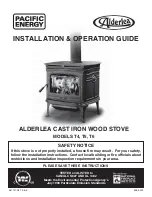
9
Vermont Castings Concord
30005102
To meet these requirements, a floor protector must be
at least 54” (1372 mm) wide (“A”,Fig. 12) and 52” (1320
mm) deep (“B”, Fig. 12).
fireplace hearth protection
Do not assume that your fireplace hearth is completely
noncombustible. Many fireplace hearths do not satisfy
the “completely noncombustible” requirement because
the brick or concrete in front of the fireplace opening is
supported by heavy wood framing. (Fig. 13) Because
heat is readily conducted by brick or concrete, it can
easily pass through to the wood. As a result, such fire-
place hearths can be a fire hazard and are considered
a combustible floor.
For all fireplace installations, follow the floor protection
guidelines described above.
Keep in mind that many raised hearths will extend
less than the required clearance from the front of the
heater when it is installed. In such cases, sufficient
floor protection as described above must be added in
front of the hearth to satisfy the minimum floor protector
requirement from the front of the stove: 18” (460 mm)
from the front in the United States and 18” (460 mm)
from the front in Canada.
Hearth rugs do not satisfy the requirements for floor
protection as they are only fire-retardant, not fire proof.
ST247a
Rear exit floor dgrm
12/14/99 djt
fig. 13
Supporting timbers under fireplace hearths are
considered to be combustible.
Wood framing
requires protection
from radiant heat
ST247a
clearance to Surrounding
combustible materials
When the stove is operating, both the stoveplate and
the chimney connector radiate heat in all directions. A
safe installation requires that adequate clearance be
maintained between the stove and nearby combustible
materials to ensure that those materials do not over-
heat.
Clearance is the distance between either your stove
or chimney connector, and nearby walls, floors, the
ceiling, and any other fixed combustible surface.
keep
furnishings and other combustible materials away
from the stove as well.
In general, a distance of 48”
(1219 mm) must be maintained between the stove and
moveable combustible items such as drying clothes,
furniture, newspapers, firewood, etc. Keep this area
empty of any combustible material.
Safe ways to reduce clearances
The Concord clearance requirements, and diagramed
on Pages 12-13, have been established through testing
to UL and ULC standards to meet most installation con-
figurations. These involve four basic variables:
• When neither the chimney connector nor the wall
has a heat shield installed.
• When only the chimney connector has a heat
shield installed.
• When only the wall has a heat shield mounted on
it.
• When a heat shield is installed on both the chim-
ney connector and wall.
In general, the greatest clearance is required when the
stove will be positioned with no heat shield near a wall
with no heat shield. The least clearance is required
when both the stove and the wall have heat shields.
Reducing a stove clearance may require installation of
a heat shield on the chimney connector as well.
Clearances may be reduced only by means approved
by the regulatory authority, or in accordance with the
clearances in this manual.
D
A
B
A
D
C
C
E
C
E
C
Top Vent
Rear Vent
F
St500a
Madison
floor protection
7/26/01 djt
fig. 12
These dimensions are minimum requirements only.
Use greater dimensions whenever possible.
floor protection requirements
A: 48”
54” (1372 mm)
B: 48”
52” (1321 mm)
C: 4”
8” (203 mm)
D: 18”
18” (457 mm)
E: 16”
18” (457 mm)
F: 10”
10” (254 mm)
u. S.
canada
ST500a










































